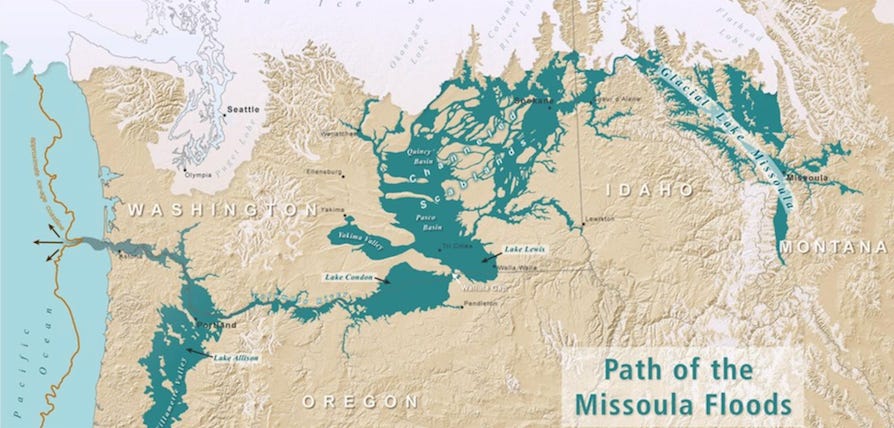Ten days ago, my wife and returned to the ice age, or what geologists call the Last Glacial Maximum (LGM). Sadly, we were not in a time machine because if I could go back to any point in time, I’d head straight to some prominent knoll to watch the great Missoula floods. Super agents of erosion during the LGM (now you can see why I introduced the term because it saves me from having to write out last ice age), they are one of the most amazing geological events of the past 4.5 billion years.
Triggered by ice dam failure at Glacial Lake Missoula (about the volume of 600 Lake Washingtons), water equal to ten times the volume of all the rivers now flowing on earth raged out and ripped and rippled across what is now northern Idaho and eastern Washington. The onslaught of water, which occurred at least 89 times, sculpted the landscape, creating the planet’s largest ripples, massive waterfalls, and what surely must have been ginormous towheads, or sandbars and shoals. (I admit I dropped towhead in because I just learned what it meant.) Now, you know why I’d want to see these epic floods…and be up on a high ridge away from the water.
But back to the present and our ice age encounter. We were hiking the Oyster Dome trail, up above Chuckanut Drive, when we emerged out of the trees at the top and found ourselves in glorious sunlight. Below us, a fog sea covered the Salish Sea. To the southwest rose the Olympic Mountains and slightly north was the top of Lummi Island. The image below is not exactly what the Puget lowland would have looked like during the LGM, but it gives a good feel: a massive stretch of white that extended south to about Olympia with high foothills and the Cascade and Olympic mountains poking above, and covered in much larger alpine glaciers than at present.
One significant difference is that the Oyster Dome (2,025 feet) would have been covered by ice. Based on glacially abraded bedrock and glacial erratics (rocks carried by the glacier and dropped when the ice melted), geologists have determined that glacier was 3,000 feet thick in Seattle and 5,000 feet thick in Bellingham at the ice’s greatest extent. In other words, several thousand feet of ice would have been above the location where my wife and I were standing, which means, of course, that the sea of ice would have covered a lot more land and ruined our hike.

But still, I like to imagine that what we saw last week was a tantalizing vision of what happened here many times. Geologists have found evidence for at least seven ice ages in the Puget lowland over the past two million years. Each time the ice plowed south (advancing about a soccer pitch a year), it pushed between the mountain ranges, scraped and shaped, and left behind a tabula rasa eventually pioneered by new ecosystems.
After the ice retreated, or melted, the last time—about 15,500 years ago, at about twice the speed it advanced—the first plants created an open, hemlock- and oak-dominated savannah habitat, teeming with mastodons, Columbian mammoths, giant sloths, bison (2x bigger than modern ones), and short-faced bears. They didn't survive long (either due to climate change or to too many people hunting the charismatic megafauna) and sadly, were extinct by about 11,000 years ago. Continued warming later led to more conifers and denser forests until, by about 5,000 years ago, the ecosystem looked like our modern one of a temperate rainforest interspersed with prairies, bogs, and burnt patches (both natural and human enhanced.)
How strange would it be if a massive sheet of ice covered this region now, and we only could see it as visitors who had traveled north to experience a world so different from our homes in the ice free south. We take for granted that we live in an interglacial period but many generations of our species worldwide inhabited an icy world much more daunting than our present. One advantage, though we seem to be doing our best to counter it, of living in our interglacial is the relatively benign climate. Even compared to those who lived south of the continental ice sheets, our modern climate has conditions generally favorable to climates of tens of thousands of year ago.
None of us alive today will experience as dramatic of difference as exists between now and the last ice age. Fortunately, though we occasionally get the right climatic conditions to allow us to time travel and get a glimpse of that former world.
If you’d like to subscribe to this newsletter (either free or paid), click on this handsome button.
I have two upcoming events where I will be speaking about Homewaters and hope.
Feb 5 - SoundWaters University keynote at 1pm.
Feb 10 - WildSociety Winter Speaker Series at 6:30pm.







I always am amazed at the interesting information you present.
Particularly interesting piece, David - thanks. As many times as I've travelled between Missoula and Seattle, I could never envision the route of the Missoula floods. The map was an invaluable tool. Keep up the good work.